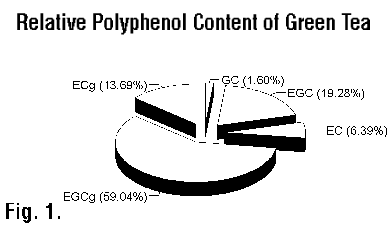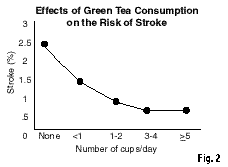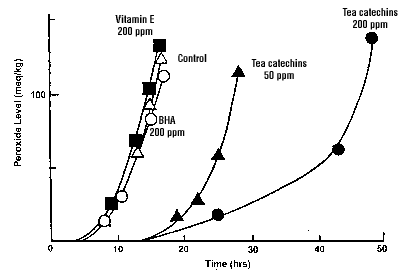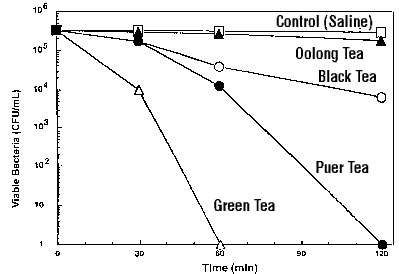
INfertility Workshop is getting a new face and a new place. Please visit us at InfertilityWorkshop.com/BLOG where it is all happening.
The prefecture of Shizuoka, Japan has twoclaims to fame. First, it is the heart of this tea-drinking country's tea region. Not onlydo the inhabitants grow and process huge amounts of tea here, they also produce- andconsume- large amounts of tea-containing products, including tea-flavored gum, candy,toothpaste, and even shampoo, not to mention drink multiple cups of tea every day.
Shizuoka is also becoming well known because of its extraordinarily low death rate fromcancer, especially stomach cancer. When Japanese researchers looked more closely at thedemographics of the region, they found that those towns with the highest tea consumptionhad the lowest levels of cancer.1
Coincidence? Not likely. Recent scientific studies are confirming at least 4000 yearsof folklore and medical practice in Asia regarding the incredible health benefits of greentea. Tea, and especially green tea, which is second only to water as the most common drinkin the world, may also be the single most valuable substance you can take to protect yourgeneral health. The many health benefits of tea, all of which have been demonstrated inscientific studies, include:
- Antioxidant activity
- Cancer protection
- Cholesterol reduction
- Blood pressure reduction
- Antibacterial and antiviral activity
- Protection against radiation
- Reduction of body fat
- Reduction of blood sugar
Tea Polyphenols
 |
The key fraction of the tea leaf (Camellia sinensis) that provides all these healthbenefits is a group of phytochemicals known as polyphenols. Long known as tea tanninbecause of their pungent taste, polyphenols constitute 15 to 30% of unfermented driedgreen tea and most of the soluble portion of tea. Thus, when you drink a cup of green tea,you're basically drinking a solution of tea polyphenols. In fresh, unfermented tea leaves,polyphenols exist as a series of chemicals called catechins, which include gallocatechin(GC), epigallocatechin (EGC), epicatechin (EC), epigallocatechin gallate (EGCg), andepicatechin gallate (ECg). As you can see in Figure 1, the largest component of fresh tealeaves is EGCg, which is fortunate, because it is also the most potent.Our focus so farhas been on green tea, but we Westerners are most familiar with black tea, which hassignificantly fewer polyphenols, and thus appears to be generally less beneficial. Bothblack and green tea come from the same source, but the leaves that eventually become blacktea are first broken up and exposed to air. This process promotes oxidation anddeactivation of the valuable polyphenols. Green tea, on the other hand, is processed in away that protects polyphenols by destroying the enzyme that oxidizes them. Consequently,green tea may contain as much as 90% more polyphenols than black tea. Before you run downto your local market to pick up some green tea, consider first that the amount ofprotection you get from green tea is directly proportional to how much of it you drink2(Fig.2).
 |
Sipping a cup at breakfast might help a little, but to reap the full protective rewardsof green tea, you need to drink at least 5 to 10 cups a day. This level of tea consumptionis not uncommon in Asia, but for most Americans it probably represents a significantshift.But take heart, drinking tea is not the only way to obtain its health benefits. Onceit was discovered that tea catechins play such an important protective role, Japanesescientists went to work to isolate these key ingredients and translate them into a formthat would (1) concentrate the nutrients in a smaller package and (2) put them in avehicle that would be more accessible to non-tea drinkers. The result of these efforts isin Proancynol. Each capsule contains 40mg of green tea extract. Each capsulealso contains 15 % grapeseed extract and 15% pine bark for a well rounded product.
The clinical benefits of green tea are truly extraordinary. The following is a briefoverview of some of the most important studies of the effects of tea on various diseasestates.
Cancer Protection
In addition to the observations of the people of Shizuoka, it is well known thatJapanese men get less lung cancer than American men even though they smoke morecigarettes. It is thought that this difference may be due to their consumption of greentea. One study compared the frequency of a particular marker of lung cancer, thedegradation of lymphocytes, in smokers and nonsmokers. Known as SCE (sister chromatidexchange in mitogen-stimulated peripheral lymphocytes), this marker was found to besignificantly elevated in smokers who did not drink green tea whereas, in those who drankgreen tea, the SCE frequency was comparable to that of nonsmokers.3
When mice were exposed to the carcinogens in cigarette smoke, those fed green teaextract had 45% lower incidence of lung cancer than their control counterparts.4 Scoresof similar studies have also demonstrated protection against cancers of the esophagus,stomach, skin, breast, pancreas, colon/rectum, and liver in vitro, in tea-drinking humans,and in animals fed green tea.5-10 Green tea has been found to be effective evenagainst established skin cancers in mice.11, 12
| "Japanese researchers... found that those towns with the highest tea consumption had the lowest levels of cancer." |
Exactly how green tea fights cancer is currently under investigation in laboratoriesall over the world. Current theories are focusing on the antioxidant and antiproliferativeeffects of polyphenolic compounds. It is also thought that these polyphenols may inhibitcarcinogenesis by blocking the endogenous formation of N-nitroso compounds, suppressingthe activation of carcinogens, and trapping genotoxic agents.13 It may bepossible that EGCg and other tea catechins block the interaction of tumor promoters withtheir receptors. This phenomenon has been described as having a kind of"sealing" effect, because these factors are neutralized by sealing them off fromthe receptors.14
Superior Antioxidant Activity
 |
| Fig. 3. Anioxidative activity of tea catechins, vitamin E, and BHA on salad oil. |
The antioxidant fraction of green tea extract has been shown to efficiently scavengepro-oxidants such as hydrogen peroxide, the superoxide anion radical,15 and theascorbyl radical.16 In a study comparing the antioxidant effects of green teaand black tea, green tea was found to be six times more potent. Curiously, thisantioxidant activity may be attenuated by drinking tea with milk, possibly because themilk proteins neutralize the tea polyphenols.17Green tea's antioxidant activityis particularly important for preventing lipid peroxidation, a crucial step in theformation of atherosclerotic plaque. Since lipid peroxidation is also a factor in thespoilage of oils and fatty constituents of many foods, antioxidants, including polyphenolsand vitamin E, are often added to prevent rancidity. When two different concentrations oftea catechins were compared with two other powerful antioxidants, vitamin E and butylatedhydroxyanisole (BHA), for their ability to protect fats and oils from oxidation, teacatechins were clearly superior (Fig. 3). The tea catechins were also able to suppress thephoto-oxidation of certain oils, and showed marked synergistic effects with tocopherols(vitamin E), ascorbic acid (vitamin C) and some organic acids.
Heart Disease Protection
Green Tea provides protection against cardiovascular diseases by a variety ofactions, including reducing platelet aggregation, lowering cholesterol, and decreasingblood pressure.
Antiplatelet activity. Platelets, which are cell fragments critical to the bloodclotting process, have a tendency to clump together, or aggregate. When this occurs at thesite of a wound forming a plug (or blood clot), it can be life-saving, but when it occursinside blood vessels, it can lead to reduced blood flow, impaired oxygen delivery tocertain tissue regions, and, ultimately, cellular death. Blood clots that prevent thenormal flow of blood to the heart (heart attack/myocardial infarction) or brain (stroke)can be fatal.
Evidence suggests that Green Tea possesses pronounced antiplatelet activity.EGCg, the most potent anti-clotting component of green tea, has antiplatelet activitycomparable to that of aspirin. Unlike aspirin, though, EGCg does not irritate the stomach,and, also unlike aspirin, it blocks the platelet aggregation caused by Platelet ActivatingFactor (PAF), an action typically associated with extracts of Ginkgo biloba.18, 19
| "Tea, expecially green tea... may also be the single most valuable substance you can take to protect your general health." |
Cholesterol reducing activity. Feeding studies in animals have revealed a significanthypolipidemic action of Green Tea Extract. In one study, rats were fed a lard-enricheddiet for 28 days; the diet of some of the animals was also supplemented with Green Tea.Those rats fed the tea extract showed significant reductions in plasma total cholesterol,VLDL- and LDL- (the "bad") cholesterol, and relative increases in HDL (the"good") cholesterol.20, 21
In one experiment, rats were fed a high-fat, high-cholesterol diet. After 4 weeks, thetotal cholesterol concentration in the group that did not receive EGCg rose to more thantwice the level of the control (normal diet) group. In particular, the LDL-cholesterollevel increased by as much as 15-fold and the HDL-cholesterol level dropped by more thanhalf. The addition of 0.5% EGCg to the diet suppressed the LDL-cholesterol increase toless than 8-fold and the decrease in HDL-cholesterol was completely inhibited. In thoserats fed a diet containing 1.0% EGCg, this effect was even more pronounced. These resultssuggest that dietary hyperlipidemia can be controlled to a large degree simply byingesting a green tea extract containing EGCg.
A similar beneficial effect seems to occur in humans. In one study of more than 2000Japanese men aged 49-55, tea consumption (10 cups/day) was found to be significantlyinversely associated with serum levels of total cholesterol and LDL-cholesterol, but notwith HDL-cholesterol or triglycerides.22 Another study in a differentpopulation of more than 1300 Japanese males yielded a similar result.23
Antihypertensive Effect
In hypertension caused by high blood pressure, angiotensin I converting enzyme (ACE)converts angiotensin I to vasoconstrictive angiotensin II. By blocking this conversion, itis possible to prevent hypertension to a large degree. This is the mechanism that drugsknown as ACE inhibitors exploit to treat this disease. But ACE-inhibiting drugs are notthe only way to go.
It turns out that green tea polyphenols also have significant ACE-inhibiting ability.In one study, tea polyphenols were given to one group of genetically hypertensive ratsbeginning 1 week after weaning; a second group received a normal diet. After 16 weeks, thediets were switched. The blood pressure in the normal diet group already exceeded 200 mmHg at age 10 weeks, compared with no clear rise in blood pressure in the teapolyphenol-treated group. When the diets of both groups were switched at 16 weeks, theblood pressure soon changed accordingly. In addition, the researchers found that thehypertensive rats on a normal diet were significantly more likely to die of a stroke.
Antibacterial and Antiviral Activity
Green tea has long been a folk remedy for treating diarrhea. Recent research has nowrevealed the reason. Tea catechins are powerful antibacterial and antiviral agents whichmakes them effective for treating everything from tooth decay to HIV. Studies havedemonstrated that tea catechins can protect mice against infection by the bacteria thatcause cholera and inhibit the activity of cholera toxin;24 inhibit the growthof Clostridium spp, which contributes to a variety of human diseases resulting in suddendeath, toxicity, mutagenesis, carcinogenesis, and aging;25 and killmethicillin-resistant Staphylococcus aureus in the respiratory tract and also make thesebacteria more susceptible to oxacillin.26
| "When mice were exposed to the carcinogens in cigarette smoke, those fed green tea had 45% lower incidence of lung cancer than their control counterparts." |
No less startling is the effect of green tea extract on viral infections. Japaneseresearchers have now demonstrated that EGCg and other tea polyphenols prevent theinfluenza virus from attaching itself to normal cells, thus blocking its infectivity. Evena small amount of EGCg seems to be capable of placing a significant obstacle in the way ofthe flu virus.27 Evidence also suggests activity against infections caused byrotavirus and enterovirus, which are common causes of diarrhea.28 Perhaps thebest-documented antimicrobial effect of tea catechins is against the bacteria that causetooth decay, Streptococcus mutans. In fact, green tea is probably better thanfluoride for keeping teeth healthy.29 In one study, green tea was found to befar more effective than other forms of tea against S mutans (See Fig. 4). Anotherrecent study found that EGCg completely inhibited the growth and cellular adherence ofanother important oral bacteria, Porphyromonas gingivalis.30 It has even beensuggested that green tea be used as prophylactic treatment in root canal because of itsbroad spectrum of antibacterial and bactericidal activity.31
Using Green Tea Extract
 |
| Fig. 4. Antibacterial effect of tea against carcinogenic bacteria (S mutans) |
So for those who want all of these health benefits but are daunted by the prospect offitting 5 to 10 cups of tea into their daily routine, Proancynol solves the problem bysupplying the key tea polyphenols as well as other OPCs in a highly concentratedformulation.
Each capsule of Proancynol gives you at least 40% highly purified polyphenols,including EGCg, equivalent to as much as 10 cups of green tea. Excessive caffeine is not asignificant problem, because Green Tea contains only a fraction of what is found incoffee. 1 mg of Proancynol per pound of body weight in the beginning dropping to 2 capsuleper day for maintenance is all that is needed.
Extravagant claims are often associated with novel nutritional supplements andbotanicals, but how many possess a history as rich as that of green tea, or have beenexposed to as much scientific scrutiny? Perhaps the ancient Chinese medical book from theTang Dynasty, Lost Property of Medical Herbs, was correct when it stated,
| "Various medicines are the cure of different diseases, and tea is the cure to all diseases." |
References
1.Oguni I, Nasu K, Kanaya S, Nomura T, Yamamoto S, Hara Y. Apreliminary study on the protection against cancer risk by green tea drinking. Shizuoka,Japan: University of Shizuoka Hamamatsu College.
2. Sato Y, et al. Effects of green tea consumption on the reduction of brain-strokehistory. J Exp Med. 1989;157:337-343.
3. Shim J, Kang M, Kim Y, Roh J, Roberts C, Lee I. Chemoprotective effect of green tea(Camellia sinensis) among cigarette smokers. Cancer Epidemiol Biomarkers Prev.1995;4:387-391.
4. Brody J. Scientists seeking possible wonder drugs in tea. The New York Times. New York;March 14, 1991.
5. Hirose M, Hoshiya T, Akagi K, Takahashi S, Hara Y, Ito N. Effects of green teacatechins in a rat multi-organ carcinogenesis model. Carcinogenesis. 1993;14:1549-1553.
6. Khan S, Katiyar S, Agarwal R, Mukhtar H. Enhancement of antioxidant and phase IIenzymes by oral feeding of green tea polyphenols in drinking water to SKH-1 hairless mice:possible role in cancer chemoprevention. Cancer Res. 1992;52:4050-4052.
7. Yamane T, Nakatani H, Kikuoka N, et al. Inhibitory effects and toxicity of green teapolyphenols for gastrointestinal carcinogenesis. Cancer. 1996;77 (8 Suppl):1662-1667.
8. Ji B, Chow W, McLaughlin A, et al. Green tea consumption and the risk of pancreatic andcolorectal cancers. Int J Cancer. 1997;70:255-258.
9. Araki R, Inoue S, Osbourne M, Telang N. Chemoprevention of mammary neoplasia. In vitroeffects of a green tea polyphenol. Ann NY Acad Sci. 1995;768:215-222.
10. Liao S, Umekita Y, Guo J, Kokontis J, Hiipakka R. Growth inhibition and regression ofhuman prostate and breast tumors in athymic mice by tea epigallocatechin gallate. CancerLett. 1995;96:239-243.
11. Wang Z, Huang M, Ho C, et al. Inhibitory effect of green tea on the growth ofestablished skin papillomas in mice. Cancer Res. 1992;52:6657-6665.
12. Mukhtar H, Katiyar S, Agarwal R. Green tea and skin anticarcinogenic effects. J InvestDermatol. 1994;102:3-7.
13. Yang C, Wang Z. Tea and cancer. J Natl Cancer Inst. 1993;85:1038-1049.
14. Komori A, Yatsunami J, Okabe S, et al. Anticarcinogenic activity of green teapolyphenols. Jpn J Clin Oncol. 1993;23:186-190.
15. Ruch R. Prevention of cytotoxicity and inhibition of intercellular communication byantioxidant catechins isolated from Chinese green tea. Carcinogenesis. 1989;10:1003-1008.
16. Satoh K, Sakagami H. Ascorbyl radical scavenging activity of polyphenols. AnticancerRes. 1996;16:2885-2890.
17. Serafini M, Ghiselli A, Ferro-Luzzi A. In vivo antioxidant effect of green and blacktea in man. Eur J Clin Nutr. 1996;50:28-32.
18. Segasaka-Mitane Y, Miwa M, Okada S. Platelet aggregation inhibitors in hot waterextract of green tea. Chem Pharm Bull. (Tokyo). 1990;38:790-793.
19. Ali M, Afzal M, Gubler C, Burka J. A potent thromboxane formation inhibitor in greentea leaves. Prostaglandins Leukot Essent Fatty Acids. 1990;40:281-283.
20. Muramatsu K, Fukuyo M, Hara Y. Effect of green tea catechins on plasma cholesterollevel in cholesterol-fed rats. J Nutr Sci Vitaminol (Tokyo). 1986;32:613-622.
21. Chisaka T, Matsuda H, Kubomura Y, Mochizuki M, Yamahara J, Fujimura H. The effect ofcrude drugs on experimental hypercholesterolemia: mode of action of
(-)epigallocatechin gallate in tea leaves. Chem Pharm Bull. (Tokyo). 1988;36:227-233.
22. Kono S, Shinchi K, Wakabayashi K, et al. Relation of green tea consumption to serumlipids and lipoproteins in Japanese men. J Epidemiol. 1996;6:128-133.
23. Kono S, Shinchi K, Ikeda N, Yanai F, Imanishi K. Green tea consumption and serum lipidprofiles: a cross-sectional study in northern Kyushu, Japan. Prev Med. 1992;21:526-531.
24. Toda M, Okubo S, Ikigai H, et al. The protective activity of tea catechins againstexperimental infection by Vibrio cholerae O1. Microbiol Immunol. 1992;36:999-1001.
25. Ahn Y-J, Kawamura T, Kim M, Yamamoto T, Mitsuoka T. Tea polyphenols: selective growthinhibitors of Clostridium spp. Agric Biol Chem. 1991;55:1425-1426.
26. Takahashi O, Cai Z, Toda M, Hara Y, Shimamura T. Appearance of antibacterial activityof oxacillin against methicillin-resistant Staphylococcus aureus (MRSA) in the presence ofcatechin. Kansenshogaku Zasshi. 1995;69:1126-1134.
27. Nakayama M, Suzuki K, Toda M, Okubo S, Hara Y, Shimamura T. Inibition of theinfectivity of influenza virus by tea polyphenols. Antiviral Res. 1993;21:289-299.
28. Mukoyama A, Ushijima H, Nishimura S, et al. Inhibition of rotavirus and enterovirusinfections by tea extracts. Jpn J Med Sci Biol. 1991;44:181-186.
29. Sakanaka S, Kim M, Taniguchi M, Yamamoto T. Antibacterial substances in Japanese greentea extract against Streptococcus mutans, a cariogenic bacterium. Agric Biol Chem.1989;53:2307-2311.
30. Sakanaka S, Aizawa M, Kim M, Yamamoto T. Inhibitory effects of green tea polyphenolson growth and cellular adherence of an oral bacterium, Porphyromonas gingivalis. BiosciBiotechnol Biochem. 1996;60:745-749.
31. Horiba N, Maekawa Y, Ito M, Matsumoto T, Nakamura H. A pilot study of Japanese greentea as a medicament: antibacterial and bactericidal effects. J Endodontics.1991;17:122-124.
 BLOG
- ARTICLES
BLOG
- ARTICLES